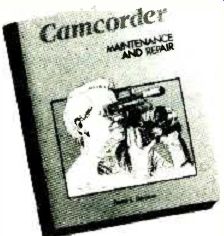
CAMCORDER MAINTENANCE AND REPAIR
By Homer L. Davidson
To most people, video equipment seems delicate and complex. Thus, whenever a camcorder or VCR fails to operate, their first thought is not How can I repair this ?, but Where can I find a repair man? That's the way I felt, too, until I read the new book by Homer Davidson and learned that a wide variety of common ills can be cured at home using nothing more than a voltmeter, a screwdriver and some common sense.
The author begins by introducing us to the various video formats such as VHS, VHS-C 8mm, Beta, and a handful of derivatives. We learn the mechanical and electronic principles on which these machines operate.
Lots of good diagrams make the discussion easy to follow. Once we understand how these devices work, the author discusses maintenance, that is, how to clean and lubricate the machines so that they stay in good working order.
He also addresses the problem of battery care and charging.
Videotape cassettes can sometimes cause problems, too, so there is one chapter devoted to cassette maintenance and repair.
The bulk of the book, however, concerns itself with what to do when the unthinkable happens, when your expensive camera or VCR grinds to a halt despite your best efforts at maintaining it in good condition. Excellent mechanical drawings show how to dismantle equipment without damaging it : Key anatomical features are illustrated in numerous photographs. The author targets common sources of trouble, such as motors and switches, and shows how to test and repair them using a DDM and some simple tools.
Every owner of video equipment should realize that sooner or later a malfunction will occur. When it does, Camcorder Maintenance and Repair will help you set things right and perhaps avoid an expensive trip to the repair shop.
The book costs $16.95 and is available from TAB Books Inc., Blue Ridge Summit, PA, 17214-9988. Or ask for it at your local bookstore.
THE HOMEBUILT DYNAMO
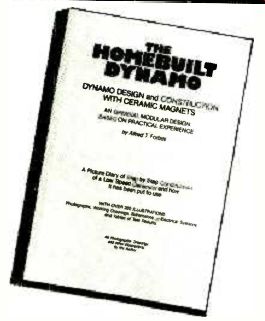
By Alfred T. Forbes
Like ostriches with their heads in the sand, Americans by and large ignored the dangers of their dependence on foreign oil during the eighties, but Iraq's invasion of Kuwait last August shattered their complacency. People think more about energy these days, and some even dream of generating their own electrical power. If you are one of these people, this new book by New Zealander Alfred Forbes may interest you. The Homebuilt Dynamo is a step–by-step, 182-page guide to the construction of a low-voltage, 3-phase AC generator and rectifier--what we would call an alternator.
Based on high-energy permanent magnets, Mr. Forbes' design is unique in that it develops considerable power at relatively low speed. Maximum rate output is 1,000 watts at 740 rpm. Depending on the rate of rotation and the manner in which the coil windings are connected together, output voltages between 12 and 36 VDC may be produced. Power to turn the armature can be obtained from a windmill, a water wheel, or even a stationary bicycle, which is the method employed by the author.
He uses the power generated to charge a battery and light his home using low-voltage fluorescent lamps.
The book has over 300 illustrations and is printed on high-quality glossy stock. Instructions are clear, but considerable mechanical aptitude will be needed to duplicate the author's work. The Home Built Dynamo is available for $65 ( U.S.) from Todd-Forbes Publishing, P.O. Box 3919, Auckland, New Zealand. Price includes airmail delivery.
INVENTING: CREATING AND SELLING YOUR IDEAS
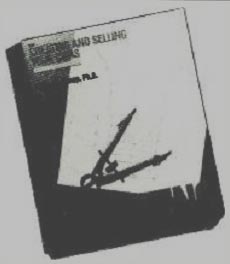
By Philip B. Knapp, Ph.D.
The setting is a cheerless basement laboratory. In the dim light we see a strange machine that appears to have been thrown together from junk parts. Standing next to the machine, a man badly in need of a haircut and shave is busy making adjustments with a screwdriver. Oops! He must have turned the wrong screw, because the machine begins to shake and emit puffs of smoke. Before the man can correct his mistake, the machine lets out a dying gasp and explodes, sending gears and springs flying through the air like shrapnel. The man dives beneath a table, then peers out cautiously.
We see in his soot-covered face a mixture of surprise and stubborn determination, and we know that it won't be long before he's built a new version of his silly machine.
Who is this character, anyhow? He is a typical inventor, as seen through the jaundiced eyes of a Hollywood scriptwriter. Little wonder, then, that to many people the word inventor is synonymous with crackpot. The first thing Philip Knapp does in his new book is to lay to rest the hackneyed stereotype of the inventor. Dr. Knapp, himself an accomplished inventor with 20 patents and more than 50 inventions to his credit, portrays the inventor as a creative problem-solver, someone more in tune with reality than most of his detractors. The author goes on to show us what inventing is really like, using some of his own inventions as examples. We learn the painstaking process by which an idea is transformed into a working prototype.
Once a prototype has been built and tested, the inventor must decide how his device is to be marketed. The first alternative is to sell the invention to a company and collect royalties. For someone with no business experience, this will probably be the best choice.
But how do you find a suitable company? Not through one of those classified ads that say "Inventions Wanted." Most of these people make their money on the gullibility of the inventor, not on the merits of his invention. As Dr. Knapp says, run like hell as soon as anyone asks you for a fee to promote your invention. You'll find the best sales leads for your invention in the business section of most public libraries, and the book explains how to make use of this information. The author also discusses how to negotiate with a company that's interested in your invention. To protect yourself, don't show them the prototype until after the contract is signed.
Too many inventors have been cheated out of their just rewards by unscrupulous wheeler-dealers.
The alternative to selling your invention to a company is to form your own company and manufacture the invention yourself. For most inventors without business experience this could be the road to ruin, but for those who prefer to do it this way, the author furnishes complete information on formulating a business plan, raising capital, dealing with lawyers, setting up a production line, marketing the product, and running the business. What he doesn't cover you can find by reading the books listed in the extensive bibliography.
I think this is a terrific book, and a good value, too. Whither you have a specific invention in mind, or are just curious about inventing in general, Inventing: Creating and Selling Your Ideas is a book you ought to read. The price is $15.95 and the publisher is TAB Books Inc., Blue Ridge Summit, PA, 17214-9988.
THE EMPLOYMENT MAZE
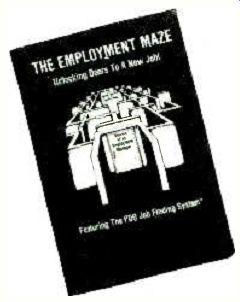
By Paul Dombroski, David Hage, and Dennis Hage
As America entered the twentieth century, most of its working citizens were self-employed. They were farmers, or shopkeepers, or lawyers, or a hundred other things; and they were their own bosses.
Today, on the threshold of the twenty-first century, the situation has reversed itself: big corporations and big government dominate the economic landscape, and most people work for someone else. Under such conditions, the key to success may not lie in working hard, but in working someplace else.
Paul Dombroski, personnel manager at an electronics firm in the southwest, along with associates David and Dennis Hage, has written a book that will enable the ambitious job-seeker to find the kind of job he wants. The author advocates establishing a network of influential friends to help in the job search, since the choicest job openings are often filled by personal recommendations and referrals. He tells how and when to respond to employment ads, and how to write a resume that will elicit a response from a personnel manager.
Employment agencies are sometimes necessary in a job search; Mr. Dombroski tells how to get the most out of them. Once you've got the attention of a prospective employer, you face one last hurdle: the job interview. How you handle yourself in such an interview is crucial to winning the job you seek. Like or not, you have to sell yourself and convince the employer that he's found a valuable asset. Mr Dombroski offers welcome advice on how to do this.
The Employment Maze is a fast-paced 136-page book that you can read in an hour or two, yet the information it contains could affect the rest of your life. Copies may be ordered from Paul Dombroski Inc., POB 47604, Phoenix, AZ, 85068. Price is $12.95 plus $2.00 for postage.
CUSTOMIZE YOUR HOME ENTERTAINMENT SYSTEM
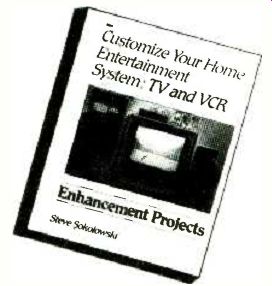
By Steve Sokolowski
Popular author Isaac Asimov recently marked a milestone in his long career with the publication of his 300th book. I mention this because it appears as if Steve Sokolowski has his sights set on Dr. Asimov's record: this is the third book of Steve's to be reviewed this year, and it looks like his best to date. This time out, Steve brings us a collection of easy-to-build projects designed to add new features and enjoyment to a TV, VCR, or stereo system.
The roster of projects consists of 22 items: tunable notch filter, audio delay line, equalizer, noise reducer, low-voltage power amplifier, two-watt audio amplifier, four-watt audio amplifier, rear-speaker ambience amplifier, bass-boost filter, stereo audio control, VU meter, audio power meter, stereo simulator, infrared audio transmitter and receiver, surround-sound decoder, VCR AC controller, stereo adapter for TV, tone controller, stereo audio switch, and various power-supply circuits to power the projects presented.
In addition to the projects, there are chapters on TV and VCR theory, assembly tips, reading schematic diagrams, making printed circuit boards, and soldering. The book is thus a self-contained introduction to project building that will appeal to the beginner as well as the more experienced hobbyist. Most projects require only two or three integrated circuits and a handful of other components, so you can assemble them quickly and inexpensively. PCB layouts accompany most of the projects.
Customize Your Home Entertainment System is an excellent book of projects, reasonably priced at $15.95. Order from TAB Books Inc., Blue Ridge Summit, PA, 17214-9988, or your local bookstore.
DESIGN AND APPLICATION OF SMALL STANDARDIZED COMPONENTS
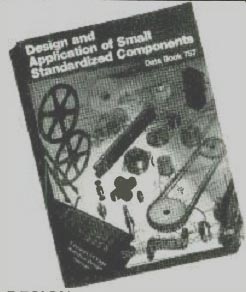
By the Staff of Stock Drive Products
As electronic enthusiasts we share a common interest: we like to build things, great Rube Goldberg-style contraptions with whirring and clicking parts, gadgets that amaze our neighbors and cause even the most tolerant spouses to grit their teeth. This is our role in life, and we play it with gusto. For inspiration, we read Electronics Handbook and half a dozen other electronics magazines, which, out of courtesy to our publisher, shall remain nameless here. These magazines provide a vital forum for the dissemination of the new ideas and techniques in the field of electronics. However, most projects are not strictly electronic devices; they have a mechanical structure as well, yet I can think of no popular periodical that addresses mechanical concepts in the same way that magazines like Electronics Handbook and others treat electronic concepts. As a result, the mechanical part of a project is often approached with little or no theoretical insight. Things are put together in a trial-and-error fashion from whatever mechanical parts are at hand, and it is a testament to human ingenuity that many of these projects work at all.
As an antidote to the current deplorable state of mechanical knowledge, let me recommend the Design and Application of Small Standardized Components, an easy-to-understand guide to the theory and application of mechanical components like pulleys, belts, gears, motors, and so on.
This book was prepared by the staff of Stock Drive Products, a major supplier of small, precision mechanical components The purpose of this book is to explain in simple language how best to apply the mechanical components that Stock Drive Products sells. Of course, the information applies equally well to components from other manufacturers.
Chapter One is a compendium of useful mechanical data, most of it in chart form, dealing with such things as conversion factors, moments of inertia, properties of metals, properties of plastics, characteristics of finishes and coatings, and practical hints for mechanical design.
Chapter Two is an excellent, thorough introduction to the design and application of gears and gear trains. Let me point out, however, that most home projects should probably be constructed with belts, chains, and pulleys, since these are easier for the novice to lash together than a gear train. But for those times when you just can't avoid using gears, Chapter Two will pull you through.
Chapter Three is about electricity, probably nothing that you don't already know. Chapter Four is about motors, and here there is likely to be lots that you don't know. The treatment of stepper motors is especially thorough.
Chapter Five deals with spring motors, handy devices that can replace an electric motor or a counterweight in certain applications. Shaft couplings and universal joints are discussed in Chapter Six. Belt drives, chain drives, and pulleys are explained in Chapter Seven, which for most readers will be the most important chapter of the book. This chapter is augmented by an extensive set of center-distance tables which make the design of belt-driven systems easy.
Chapter Eight is all about shafts and bearings, Chapter Nine deals with techniques for the damping or elimination of vibration, and the book ends with a final chapter on elements of robotic design.
To sum up, the Design and Application of Small Standardized Components is a 784-page handbook of practical mechanical design. You don't have to be a mechanical engineer to under-stand it, and you won't go broke buying it, since the price is just $7.95 (soft cover) or $12.95 (hard cover). This book is available from Educational Products, P.O. Box 606, Mineola, NY, 11501.
THE BEGINNER'S GUIDE TO RADIO CONTROL SPORTS FLYING
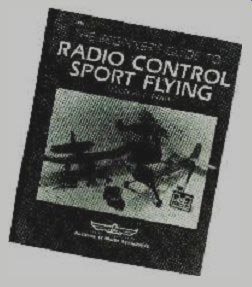
By Douglas R. Pratt
The flying of radio-controlled model airplanes dates back to at least the 1940's, and possibly earlier. Back in those days, you not only built your own airplane, you built the transmitting and receiving equipment as well, and you had to have a ham license to use the equipment. Things have changed considerably since then.
Factory-built transmitters and receivers are readily available, and you don't need a ham license to use them. You can still build your own airplane, if you wish, or you can buy one that's ready to fly.
Before you even consider buying a plane and an R/C control system, however, I suggest that you take a look at Douglas Pratt's new book, The Beginner's Guide to Radio Control Sport Flying. In it, you'll find all the information necessary to get started in R/C modeling. Mr. Pratt is special-projects director of the Academy of Model Aeronautics, the national organization for model fliers. He knows a lot about planes and flying, and he conveys what he knows with good-natured enthusiasm.
One of the things that the author stresses is the desirability of joining an R/C modeler's club. For the beginner, clubs provide camaraderie as well as free advice from more experienced members.
In addition, clubs carry insurance that protects their members, so if you lose control of your plane and it crashes through someone's window, the insurance company pays the bill.
Most of the book is devoted to the technical aspects of R/C flying.
For example, the author discusses the operation of transmitters, receivers, and servos. He stresses the importance of periodic testing of the control system to prevent possible disasters in the air. And he tells how third-order intermodulation from other nearby transmitters can cause you to lose control of your plane.
Construction tips are sprinkled liberally throughout the book. There is even advice on choosing a plane. For the beginner, a plane that is easy to build and easy to control makes sense. You want a plane that is slow and stable, not something designed for high-speed aerobatics. If your flying space is limited, an R/C helicopter might be the answer. On the other hand, someone with lots of space, who likes peace and quiet, might prefer an R/C sailplane.
With the exception of the sailplane, all planes need an engine of some sort. The bigger the plane, the bigger the engine required. Most beginners start out with an economical, 2-stroke engine. These are ignited by glow plugs and burn a mixture of methanol, nitro-methane and oil, with methanol being the major constituent. Since the fuel is very flammable, caution is necessary.
Diesel and gasoline-powered engines are also available. In recent years, 4-stroke engines have become popular, especially with scale modelers, who prefer the realistic rumble of a 4stroke engine to the thin whine of a 2-stroke. A large 4-stroke engine may put out 3 horsepower and cost as much as $3,000. Douglas Pratt's book was a pleasure to read, and I recommend it without hesitation to anyone contemplating the purchase of an R/C model plane. The Beginner's Guide to Radio Control Sport Flying costs $9.95 and is published by TAB Books Inc., Blue Ridge Summit, PA, 17214-9988.
Also see: New Book Reviews (1992)
adapted from: Electronics Handbook Vol. X